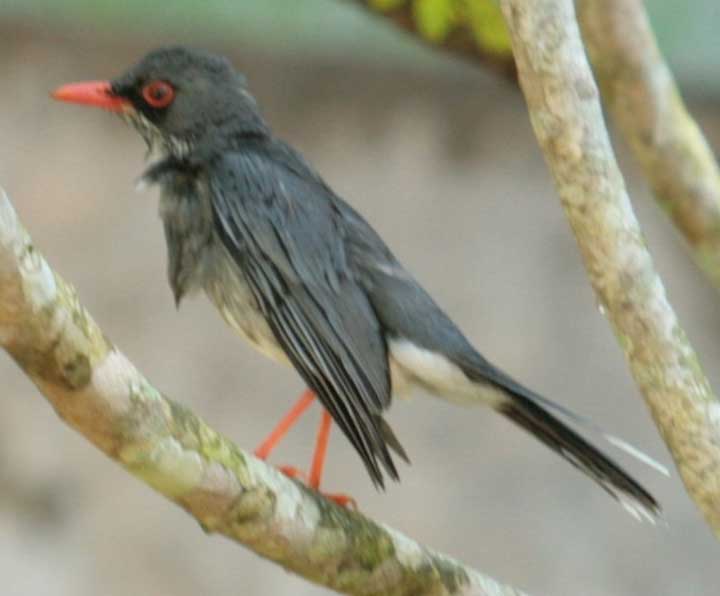
Red-legged Thrush, Turdus plumbeus
Superregnum: Eukaryota
Regnum: Animalia
Subregnum: Eumetazoa
Cladus: Bilateria
Cladus: Nephrozoa
Superphylum: Deuterostomia
Phylum: Chordata
Subphylum: Vertebrata
Infraphylum: Gnathostomata
Superclassis: Tetrapoda
Cladus: Reptiliomorpha
Cladus: Amniota
Classis: Reptilia
Cladus: Eureptilia
Cladus: Romeriida
Subclassis: Diapsida
Cladus: Sauria
Infraclassis: Archosauromorpha
Cladus: Crurotarsi
Divisio: Archosauria
Subsectio: Ornithodira
Subtaxon: Dinosauromorpha
Cladus: Dinosauria
Ordo: Saurischia
Cladus: Eusaurischia
Cladus: Theropoda
Cladus: Neotheropoda
Cladus: Averostra
Cladus: Tetanurae
Cladus: Avetheropoda
Cladus: Coelurosauria
Cladus: Maniraptoromorpha
Cladus: Maniraptoriformes
Cladus: Maniraptora
Cladus: Pennaraptora
Cladus: Eumaniraptora
Cladus: Avialae
Infraclassis: Aves
Ordo: Passeriformes
Subordo: Passeri
Infraordo: Passerida
Superfamilia: Muscicapoidea
Familia: Turdidae
Genus: Turdus
Species: Turdus plumbeus
Subspecies: T. p. albiventris – T. p. ardosiaceus – T. p. coryi – T. p. plumbeus – T. p. rubripes – T. p. schistaceus
Name
Turdus plumbeus Linnaeus, 1758
References
Linnaeus, C. 1758. Systema Naturae per regna tria naturae, secundum classes, ordines, genera, species, cum characteribus, differentiis, synonymis, locis. Editio Decima, Reformata. Tomus I. Holmiæ (Stockholm): impensis direct. Laurentii Salvii. 824 pp. DOI: 10.5962/bhl.title.542 [first availability: page 169] BHL Reference page.
Vernacular names
azərbaycanca: Qırmızıayaq qaratoyuq
čeština: Drozd rudonohý
dansk: Rødbenet Drossel
Deutsch: Rotfußdrossel
English: Red-legged Thrush
español: Zorzal Patirrojo
eesti: Punajalg-rästas
suomi: Antillienrastas
français: Merle vantard
Kreyòl ayisyen: Kwèt-kwèt
magyar: Vöröslábú rigó
italiano: Tordo plumbeo
日本語: オジロツグミ, ojirotsugumi
Nederlands: Roodpootlijster
norsk: Rødleggtrost
polski: Drozd karaibski
русский: Красноногий дрозд
slovenčina: Drozd bielobradý
svenska: Rödfotad trast
中文: 红腿鸫
The red-legged thrush (Turdus plumbeus) is a species of bird in the family Turdidae. Native to the Caribbean, it is found in the Bahamas, Cayman Islands, Cuba, Dominica, Hispaniola (the Dominican Republic and Haiti) and Puerto Rico. It formerly occurred on the Swan Islands, Honduras, but was extirpated there.
In Puerto Rico, the red-legged thrush is known as zorzal de patas coloradas.
Habitat
Its natural habitats are subtropical or tropical dry forests, subtropical or tropical moist lowland forests, subtropical or tropical moist montane forests, and heavily degraded former forest. This species may be considered the Caribbean counterpart of the American robin, as it has similar habits, including being a common visitor to gardens and lawns.
Description
This large thrush measures 27 cm (11 in)[2] and weighs approximately 75 g (2.6 oz), depending on subspecies.[3] It is mainly bluish-grey above and lighter-grey below with a white and black throat with a striped appearance. The legs, bill and eye ring are bright orange-red. There is notable variation in plumage between the subspecies.
External audio
Red-legged thrush call
audio icon Red-legged thrush call
Taxonomy
Six subspecies are described:[3][4]
T. p. plumbeus – Linnaeus, 1758: nominate; found on the northern Bahamas islands.
T. p. schistaceus – (Baird, S.F., 1864): found in eastern Cuba. Has beige-orange color on rear flanks and vent area. Bill is dark red with dusky tip.
T. p. rubripes – Temminck, 1826: found in central and western Cuba and on Isla de la Juventud. Has more white in throat and malar area. It also has orange lower flanks, belly and vent.
T. p. coryi – (Sharpe, 1902): found on the Cayman Islands. Paler and with less orange on underparts than T. p. rubripes.
T. p. ardosiaceus – Vieillot, 1822: found on Hispaniola (the Dominican Republic and Haiti) and Puerto Rico. Has darker underparts and less white in the undertail.
T. p. albiventris – Sclater, PL, 1889: found on Dominica. Has orange bill, feet and eye ring.
The IUCN Red List considers T. p. rubripes and T. p. ardosiaceus to be their own species, as the western red-legged thrush and eastern red-legged thrush, respectively.[5][6]
Diet
Its food is mostly fruits, but a third of its diet is animal matter: insects (caterpillars, beetles, ants, crickets, wasps), plus occasional snails, frogs, lizards and birds' eggs.[7]
References
BirdLife International (2016). "Turdus plumbeus". IUCN Red List of Threatened Species. 2016: e.T103891921A94180223. doi:10.2305/IUCN.UK.2016-3.RLTS.T103891921A94180223.en. Retrieved 17 November 2021.
Garrido, Orlando H.; Kirkconnell, Arturo (2000). Field Guide to the Birds of Cuba. Ithaca, NY: Comstock, Cornell University Press. pp. 179–180. ISBN 978-0-8014-8631-9.
Larsen, Niels (2011). Schulenberg, T.S. (ed.). "Red-legged Thrush (Turdus plumbeus)". neotropical.birds.cornell.edu/portal/home. Ithaca: Cornell Lab of Ornithology. Retrieved 12 October 2014.
Gill, F.; Donsker, D., eds. (2014). "IOC World Bird List". IOC World Bird List (V 4.2). doi:10.14344/IOC.ML.4.2.
BirdLife International (2016). "Turdus rubripes". IUCN Red List of Threatened Species. 2016: e.T103891941A104357876. doi:10.2305/IUCN.UK.2016-3.RLTS.T103891941A104357876.en. Retrieved 17 November 2021.
BirdLife International (2016). "Turdus ardosiaceus". IUCN Red List of Threatened Species. 2016: e.T103891946A104358193. doi:10.2305/IUCN.UK.2016-3.RLTS.T103891946A104358193.en. Retrieved 17 November 2021.
Oberle, Mark W. (2000). Puerto Rico's Birds in Photographs. p. 102. ISBN 0-9650104-1-4. LCCN 00-109190.
Retrieved from "http://en.wikipedia.org/"
All text is available under the terms of the GNU Free Documentation License

